check engine light TOYOTA GT86 2015 Owners Manual (in English)
[x] Cancel search | Manufacturer: TOYOTA, Model Year: 2015, Model line: GT86, Model: TOYOTA GT86 2015Pages: 464, PDF Size: 10.65 MB
Page 4 of 464

TABLE OF CONTENTSIndex
4
4-1. Maintenance and care
Cleaning and protecting
the vehicle exterior
............. 282
Cleaning and protecting
the vehicle interior ............ 285
Cleaning and protecting
the Alcantara
® area .......... 289
4-2. Maintenance
Maintenance
requirements..................... 291
4-3. Do-it-yourself
maintenance
Do-it-yourself service
precautions ....................... 294
Hood ................................... 297
Positioning a floor jack ........ 299
Engine compartment........... 301
Tires .................................... 314
Tire inflation pressure ......... 323
Wheels ................................ 325
Air conditioning filter ........... 328
Wireless remote control/
electronic key battery........ 331
Checking and replacing
fuses ................................. 335
Light bulbs .......................... 3435-1. Essential information
Emergency flashers ........... 362
If your vehicle needs to
be towed .......................... 363
If you think something is
wrong ............................... 370
Fuel pump shut off
system.............................. 371
5-2. Steps to take in
an emergency
If a warning light turns
on or a warning buzzer
sounds... ......................... 372
If you have a flat tire
(vehicles with
a spare tire) ...................... 384
If you have a flat tire
(vehicles with
an emergency tire
puncture repair kit) ........... 393
If the engine will
not start ............................ 409
If the shift lever cannot be
shifted from P ................... 412
If you lose your keys .......... 413
If the electronic key does
not operate properly ......... 414
If the battery is
discharged ....................... 418
4Maintenance and care5When trouble arises
Page 132 of 464

132 1-7. Safety information
CAUTION
SRS warning light
If the warning light exhibits any of the following conditions, there may be a
malfunction in the seat belt pretensioners and/or SRS airbag system. We
recommend that you have the system checked immediately by your nearest
any authorized Toyota dealer or repairer, or another duly qualified and
equipped professional. Unless checked and properly repaired, the seat belt
pretensioners and/or SRS airbags will operate improperly (e.g. SRS airbags
may inflate in a very minor collision or not inflate in a severe collision), which
may increase the risk of injury.
Flashing or flickering of the warning light
No illumination of the warning light when the engine switch is first turned to
the “ON” position (vehicles without a smart entry & start system), or the
“ENGINE START STOP” switch is turned to IGNITION ON mode (vehicles
with a smart entry & start system).
Continuous illumination of the warning light
Illumination of the warning light while driving
Page 153 of 464

153 1-7. Safety information
1
Before driving
Airbag manual on-off indicator information
The front passenger’s front airbag ON and OFF indicators shows you the
status of the front passenger’s SRS front airbag. When the engine switch
is turned to the “ON” position (vehicles without a smart entry & start sys-
tem) or the “ENGINE START STOP” switch is turned to IGNITION ON
mode (vehicles with a smart entry & start system), both the ON and OFF
indicators illuminate while the system is checked, after which both indica-
tors turn off. After that, “ON” or “OFF” on the ON-OFF indicator will be
illuminated according to the position of the airbag manual on-off switch.
If any of the following problems occur, it is possible that there is a mal-
function in the system. Have the vehicle inspected by any authorized
Toyota dealer or repairer, or another duly qualified and equipped profes-
sional.
• Neither “ON” nor “OFF” comes on.
• The indicator light does not change when the airbag manual on-off
switch is switched to “ON” or “OFF”.
CAUTION
When installing a child restraint system
For safety reasons, always install a child restraint system in a rear seat. In
the event that the rear seat cannot be used, the front seat can be used as
long as the airbag manual on-off system is set to “OFF”.
If the airbag manual on-off system is left on, the strong impact of the airbag
deployment (inflation) may cause serious injury or even death.
When a child restraint system is not installed on the front passenger
seat
Ensure that the airbag manual on-off system is set to “ON”.
If it is left off, the airbag may not deploy in the event of an accident, which
may result in serious injury or even death.
Page 162 of 464

162 2-1. Driving procedures
CAUTION
Use engine braking (downshift) to maintain a safe speed when driving
down a steep hill.
Using the brakes continuously may cause the brakes to overheat and lose
effectiveness. (P. 182, 188)
Do not adjust the position of the steering wheel, the seat, or the inside or
outside rear view mirrors while driving.
Doing so may result in a loss of vehicle control that can cause accidents,
resulting in death or serious injury.
Always check that all passengers' arms, heads or other parts of their body
are not outside the vehicle, as this may result in death or serious injury.
When driving on slippery road surfaces
Sudden braking, acceleration and steering may cause tire slippage and
reduce your ability to control the vehicle, resulting in an accident.
Sudden acceleration, engine braking due to shifting, or changes in engine
speed could cause the vehicle to skid, resulting in an accident.
After driving through a puddle, lightly depress the brake pedal to make
sure that the brakes are functioning properly. Wet brake pads may prevent
the brakes from functioning properly. If the brakes on only one side are wet
and not functioning properly, steering control may be affected, resulting in
an accident.
When shifting the shift lever
On vehicles with an automatic transmission, be careful not to shift the shift
lever with the accelerator pedal depressed. Shifting the shift lever to a
gear other than P or N may lead to unexpected rapid acceleration of the
vehicle that may cause an accident and result in death or serious injury.
Do not place items in the shift lever's surrounding area. It may cause incor-
rect operation.
If the shift boot is pulled out during cleaning, return it to its previous posi-
tion. If the shift boot is left pulled out, the shift lever may become difficult to
operate.
Page 169 of 464
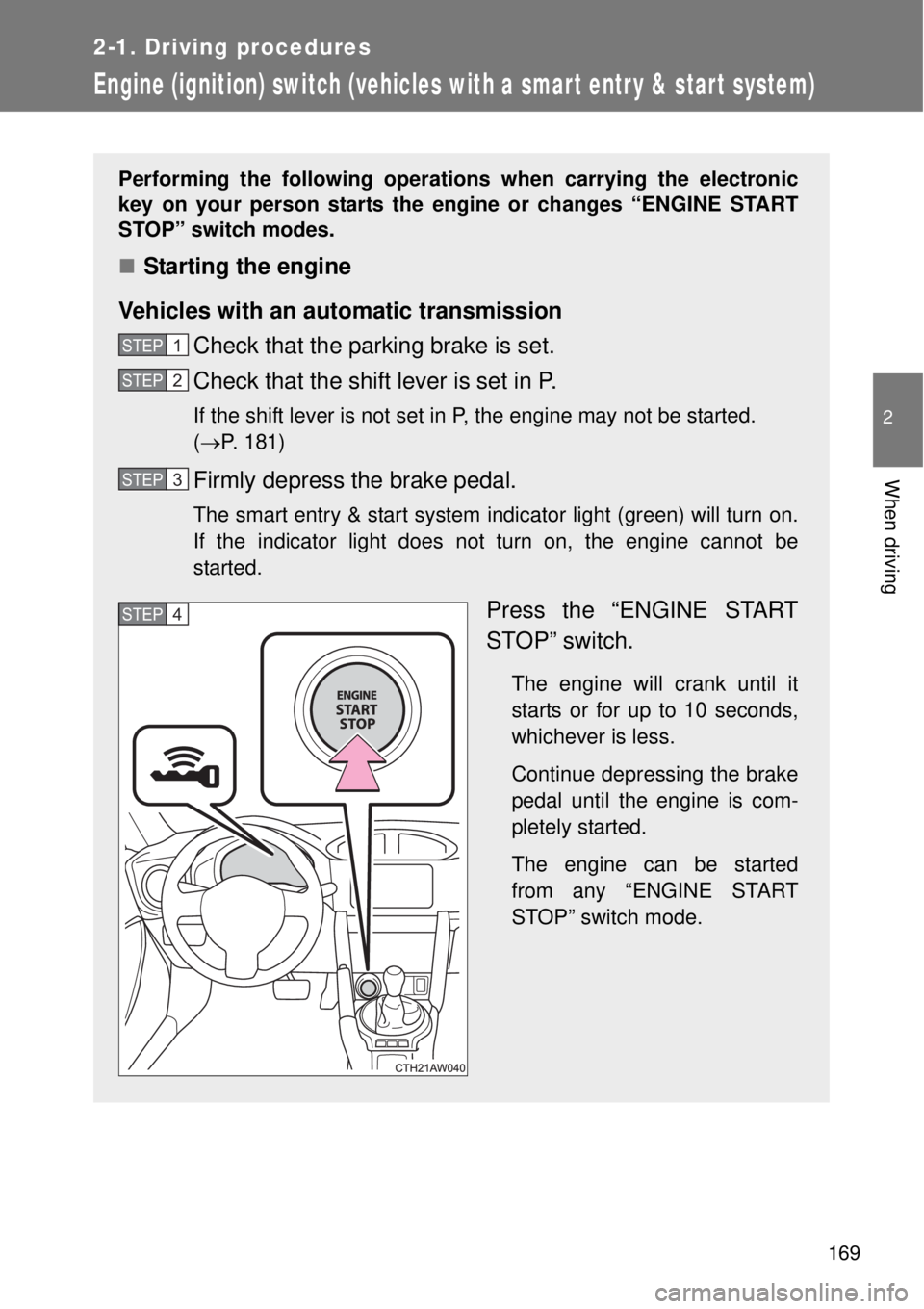
169
2-1. Driving procedures
2
When driving
Engine (ignition) switch (vehicles with a smar t entr y & star t system)
Performing the following operations when carrying the electronic
key on your person starts the engine or changes “ENGINE START
STOP” switch modes.
Starting the engine
Vehicles with an automatic transmission
Check that the parking brake is set.
Check that the shift lever is set in P.
If the shift lever is not set in P, the engine may not be started.
(P. 181)
Firmly depress the brake pedal.
The smart entry & start system indicator light (green) will turn on.
If the indicator light does not turn on, the engine cannot be
started.
Press the “ENGINE START
STOP” switch.
The engine will crank until it
starts or for up to 10 seconds,
whichever is less.
Continue depressing the brake
pedal until the engine is com-
pletely started.
The engine can be started
from any “ENGINE START
STOP” switch mode.
STEP 1
STEP 2
STEP 3
STEP 4
Page 170 of 464
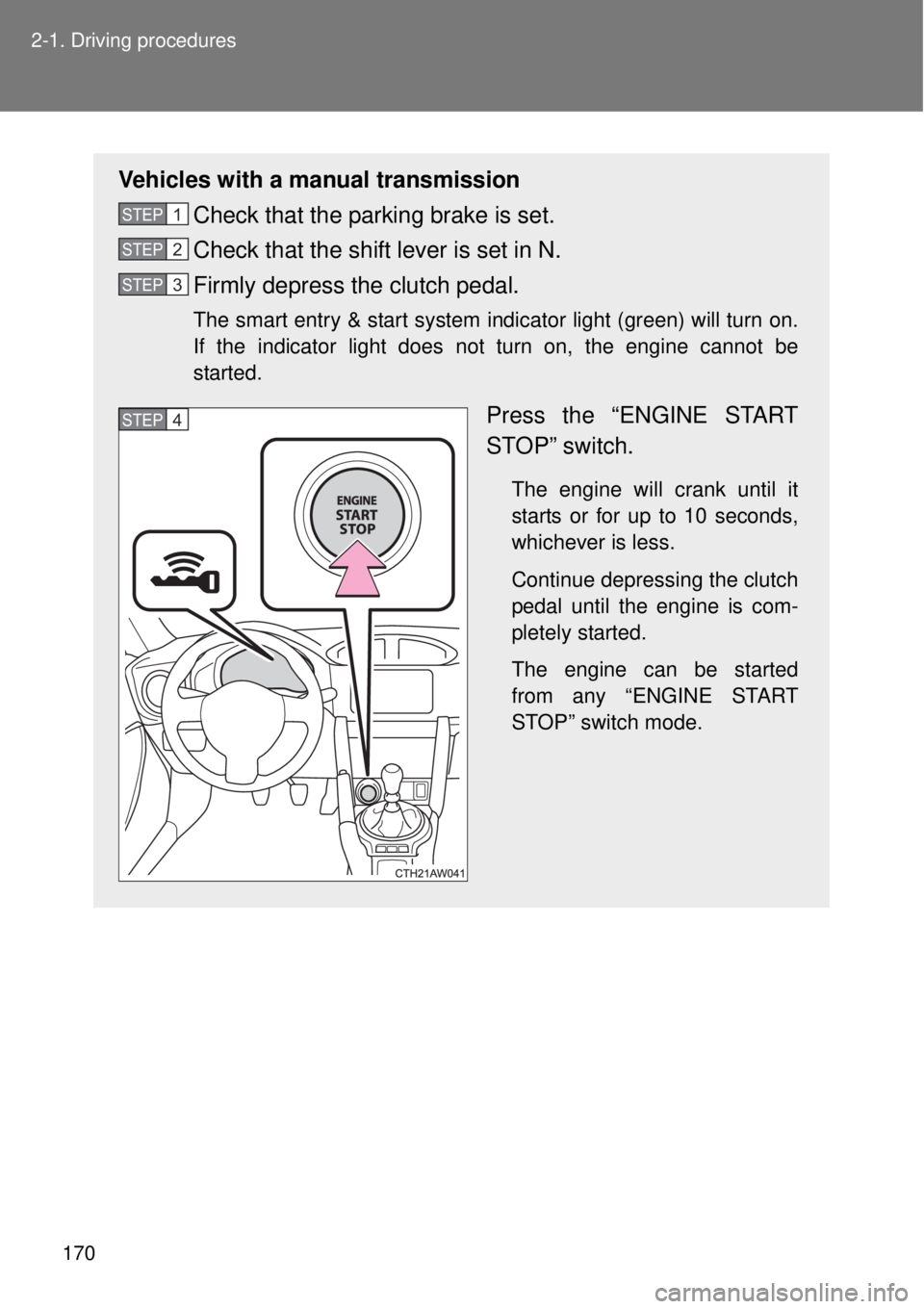
170 2-1. Driving procedures
Vehicles with a manual transmission
Check that the parking brake is set.
Check that the shift lever is set in N.
Firmly depress the clutch pedal.
The smart entry & start system indicator light (green) will turn on.
If the indicator light does not turn on, the engine cannot be
started.
Press the “ENGINE START
STOP” switch.
The engine will crank until it
starts or for up to 10 seconds,
whichever is less.
Continue depressing the clutch
pedal until the engine is com-
pletely started.
The engine can be started
from any “ENGINE START
STOP” switch mode.
STEP 1
STEP 2
STEP 3
STEP 4
Page 171 of 464
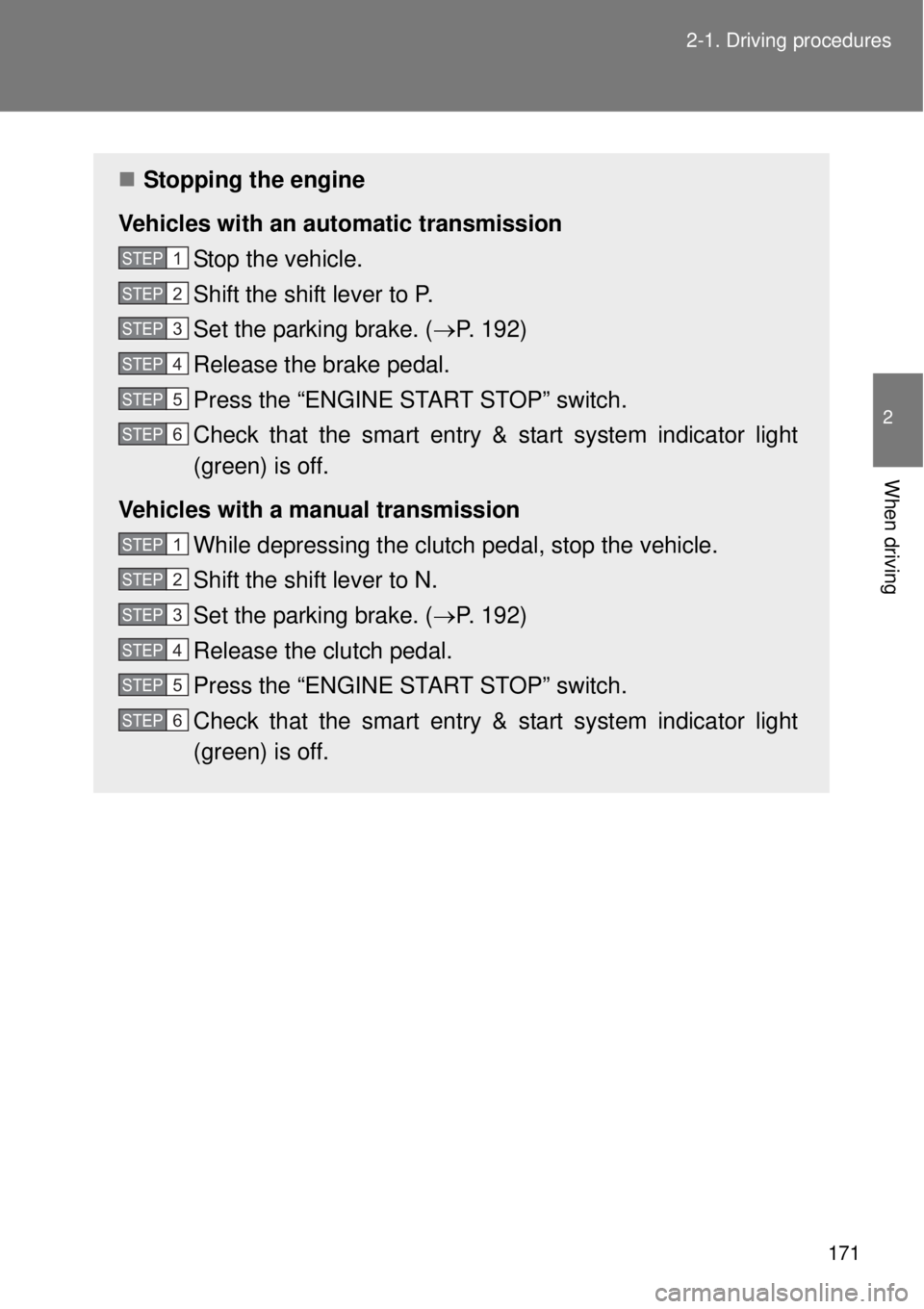
171 2-1. Driving procedures
2
When driving
Stopping the engine
Vehicles with an automatic transmission
Stop the vehicle.
Shift the shift lever to P.
Set the parking brake. (P. 192)
Release the brake pedal.
Press the “ENGINE START STOP” switch.
Check that the smart entry & start system indicator light
(green) is off.
Vehicles with a manual transmission
While depressing the clutch pedal, stop the vehicle.
Shift the shift lever to N.
Set the parking brake. (P. 192)
Release the clutch pedal.
Press the “ENGINE START STOP” switch.
Check that the smart entry & start system indicator light
(green) is off.
STEP 1
STEP 2
STEP 3
STEP 4
STEP 5
STEP 6
STEP 1
STEP 2
STEP 3
STEP 4
STEP 5
STEP 6
Page 173 of 464

173 2-1. Driving procedures
2
When driving
When stopping the engine with the shift lever in a position other
than P (vehicles with an automatic transmission)
If the engine is stopped with the shift lever in a position other than P,
the “ENGINE START STOP” switch will not be turned off but instead
be turned to ACCESSORY mode. Perform the following procedure to
turn the switch off:
Check that the parking brake is set.
Shift the shift lever to P.
Check that the smart entry & start system indicator light
(green) flashes slowly and then press the “ENGINE START
STOP” switch once.
Check that the smart entry & start system indicator light
(green) is off.
Auto power off function
Vehicles with an automatic transmission
If the vehicle is left in ACCESSORY mode for more than 20 minutes or IGNI-
TION ON mode (the engine is not running) for more than an hour with the
shift lever in P, the “ENGINE START STOP” switch will automatically turn off.
However, this function cannot entirely prevent battery discharge. Do not
leave the vehicle with the “ENGINE START STOP” switch in ACCESSORY
or IGNITION ON mode for long periods of time when the engine is not run-
ning.
Vehicles with a manual transmission
If the vehicle is left in ACCESSORY mode for more than 20 minutes or IGNI-
TION ON mode (the engine is not running) for more than an hour, the
“ENGINE START STOP” switch will automatically turn off. However, this
function cannot entirely prevent battery discharge. Do not leave the vehicle
with the “ENGINE START STOP” switch in ACCESSORY or IGNITION ON
mode for long periods of time when the engine is not running.
STEP 1
STEP 2
STEP 3
STEP 4
Page 174 of 464
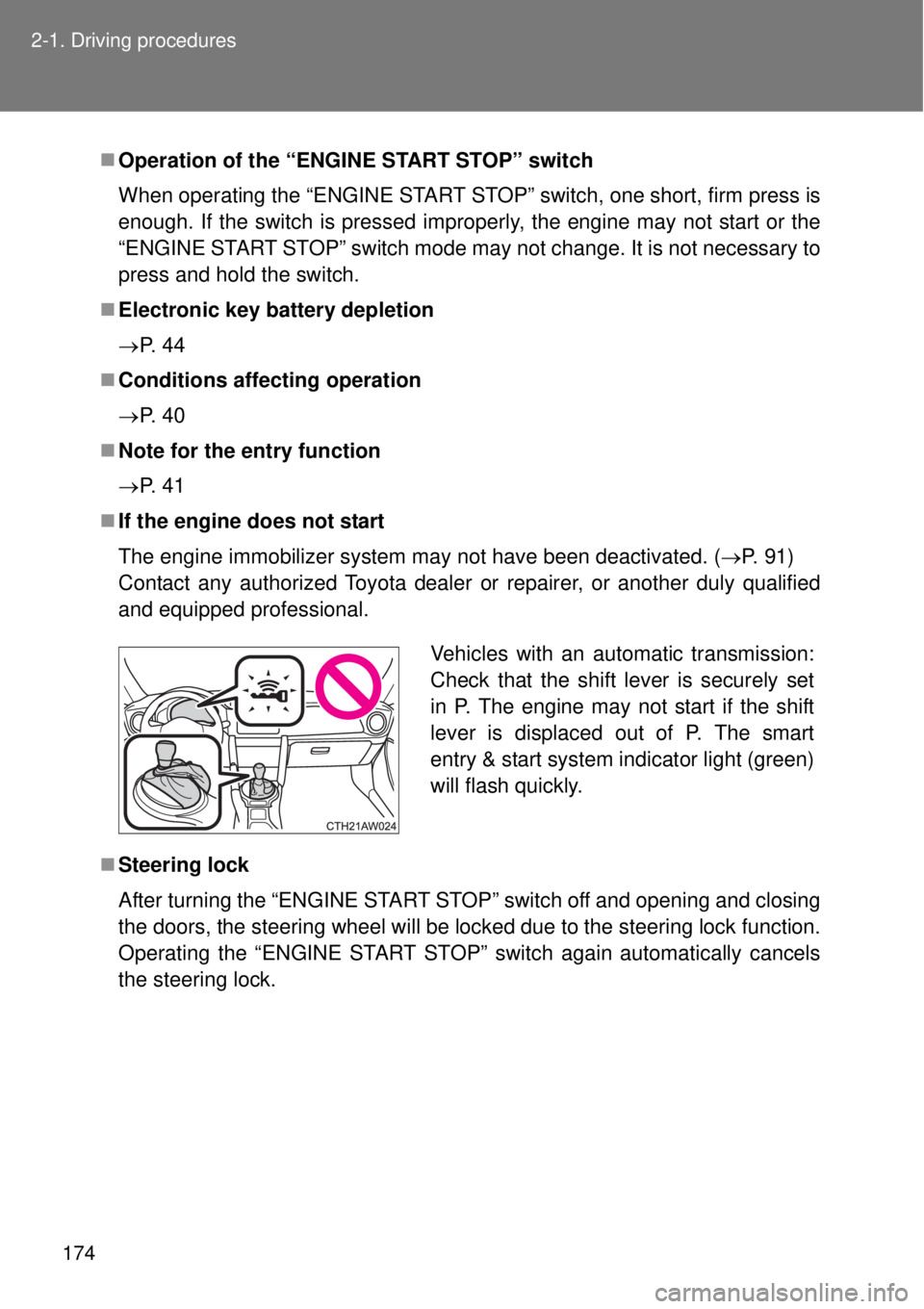
174 2-1. Driving procedures
Operation of the “ENGINE START STOP” switch
When operating the “ENGINE START STOP” switch, one short, firm press is
enough. If the switch is pressed improperly, the engine may not start or the
“ENGINE START STOP” switch mode may not change. It is not necessary to
press and hold the switch.
Electronic key battery depletion
P. 4 4
Conditions affecting operation
P. 4 0
Note for the entry function
P. 4 1
If the engine does not start
The engine immobilizer system may not have been deactivated. (P. 91)
Contact any authorized Toyota dealer or repairer, or another duly qualified
and equipped professional.
Steering lock
After turning the “ENGINE START STOP” switch off and opening and closing
the doors, the steering wheel will be locked due to the steering lock function.
Operating the “ENGINE START STOP” switch again automatically cancels
the steering lock.
Vehicles with an automatic transmission:
Check that the shift lever is securely set
in P. The engine may not start if the shift
lever is displaced out of P. The smart
entry & start system indicator light (green)
will flash quickly.
Page 175 of 464
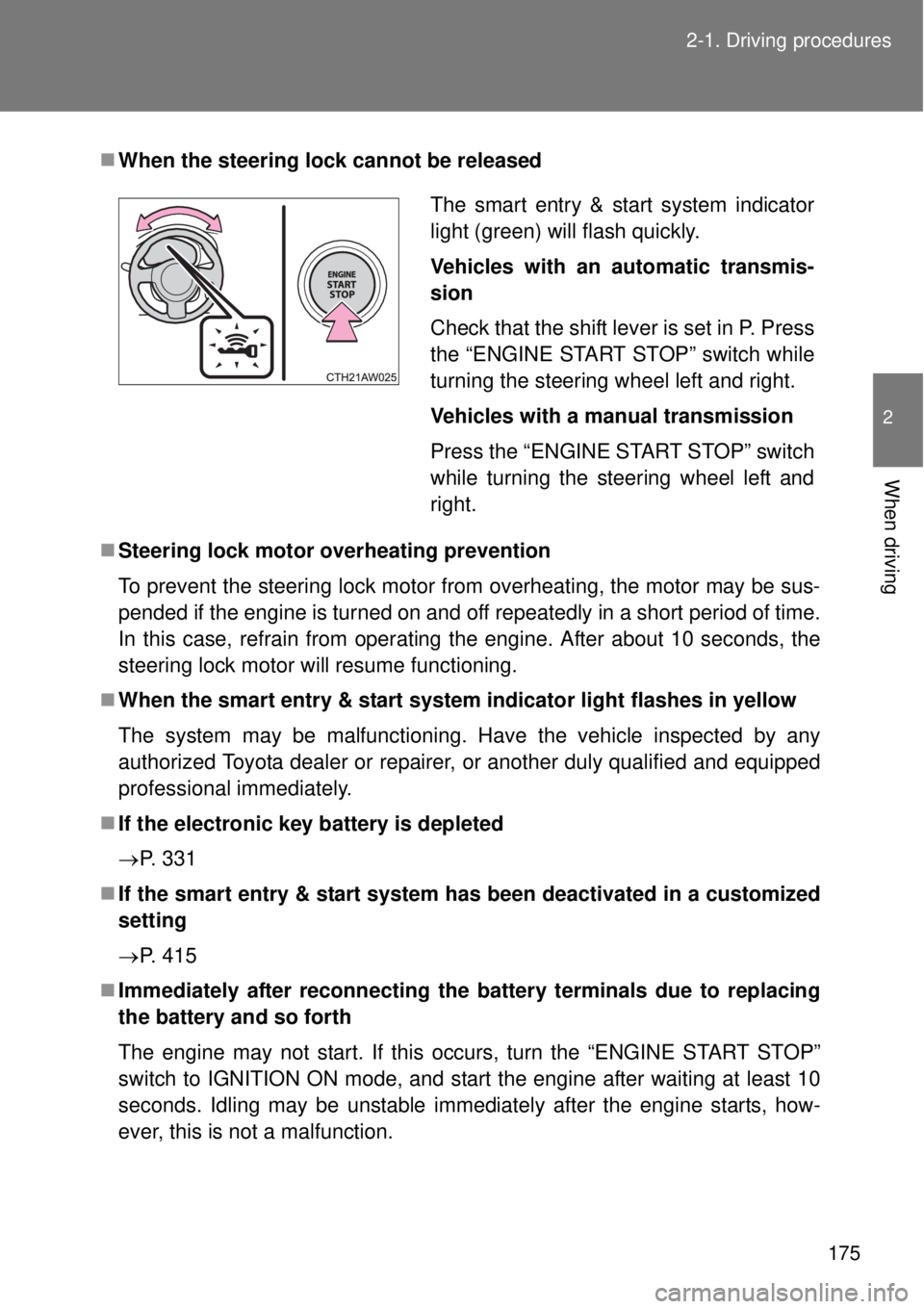
175 2-1. Driving procedures
2
When driving
When the steering lock cannot be released
Steering lock motor overheating prevention
To prevent the steering lock motor from overheating, the motor may be sus-
pended if the engine is turned on and off repeatedly in a short period of time.
In this case, refrain from operating the engine. After about 10 seconds, the
steering lock motor will resume functioning.
When the smart entry & start system indicator light flashes in yellow
The system may be malfunctioning. Have the vehicle inspected by any
authorized Toyota dealer or repairer, or another duly qualified and equipped
professional immediately.
If the electronic key battery is depleted
P. 331
If the smart entry & start system has been deactivated in a customized
setting
P. 415
Immediately after reconnecting the battery terminals due to replacing
the battery and so forth
The engine may not start. If this occurs, turn the “ENGINE START STOP”
switch to IGNITION ON mode, and start the engine after waiting at least 10
seconds. Idling may be unstable immediately after the engine starts, how-
ever, this is not a malfunction.
The smart entry & start system indicator
light (green) will flash quickly.
Vehicles with an automatic transmis-
sion
Check that the shift lever is set in P. Press
the “ENGINE START STOP” switch while
turning the steering wheel left and right.
Vehicles with a manual transmission
Press the “ENGINE START STOP” switch
while turning the steering wheel left and
right.